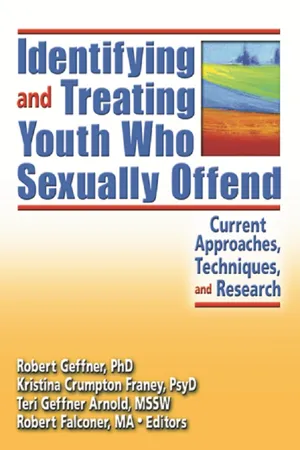
Identifying and Treating Youth Who Sexually Offend
Current Approaches, Techniques, and Research
- 355 pages
- English
- ePUB (mobile friendly)
- Available on iOS & Android
Identifying and Treating Youth Who Sexually Offend
Current Approaches, Techniques, and Research
About this book
What factors contribute to the making of a youthful sexual offender?
This book is designed to assist professionals working with youth who sexually offend. A distinguished panel of experts discusses the latest research and provides theory, techniques, and practical guidelines for the assessment and treatment of this challenging population.
Identifying and Treating Youth Who Sexually Offend: Current Approaches, Techniques, and Research lays an essential foundation with a theoretical overview that frames the subject in a clear, easy-to-follow style. This section includes:
- a comprehensive overview of the controversies, definitions, and salient characteristics of youth who sexually offend that that provides an understanding of the factors believed to be related to sex offending among youth as well as an up-to-date review of current theory
- an examination of an etiological model that is frequently applied to adult sex offendersis it applicable for use with youthful offenders?
The second section of Identifying and Treating Youth Who Sexually Offend tackles the challenges professionals face when conducting assessments of sexually abusive youth. This section is designed to help the clinicians of today and tomorrow become better equipped to handle the daunting task of assessmentfrom choosing assessment tools to decreasing denial with specific interviewing techniques. Readers will learn:
- how to distinguish subtypes among this populationwith a research review and comparative descriptions of clinical and empirical typologies as well as discussion of the Trauma Outcome Process model and practical examples for clinicians
- how to predict the rate of re-offense among youth who sexually offend, with a review of five risk assessment methods and four scales plus directions for using themincludes the Juvenile Sex Offender Assessment Protocol (JSOAP), the Protective Factors Scale (PFS), and the Estimate of Risk of Adolescent Sex Offender Recidivism (ERASOR)
- the nuts and bolts of the interviewing and clinical assessment phase of treatmenta look at effective interviewing strategies, the process of change, and the stages of change model
- the importance of family therapy in the treatment of these youthways to include parents in relapse prevention planning and ways to handle treatment providers' misconceptions and concerns about including family therapy in this type of treatment
- cognitive-behavioral treatment models for use in outpatient settingswith treatment strategies directed toward various individual or family clinical targets, including psychological dysfunctions, sexual deviance, adolescent development and adaptive skills, and parent/family relationships
- an integrated (holistic) experiential approach to treatment, complete with sample exercises and a discussion of the pros and cons of many current treatment modalities
- a multi-family group therapy (MFGT) approachwith a look at this powerful intervention mode's advantages, including economic benefits, family-to-family support and mentoring, community-based resourcefulness, and accelerated catalyzing of emotions, and directions for how to establish a MFGT format for treatment
- current practices in residential treatment for adolescent sex offenderspolicies, testing and assessment procedures, therapeutic approaches used, number of males and females in treatment, etc.
The final section of Identifying and Treating Youth Who Sexually Offend explores what happens to youth who sexually offend after they leave treatment. This includes:
- a survey of the literature on recidivism
- an evaluation of the effectiveness of treatment of 644 juvenile sex offenders through the meta-analysis of 10 studieswith encouraging results!
- a look at the life experiences of a samp
Frequently asked questions
- Essential is ideal for learners and professionals who enjoy exploring a wide range of subjects. Access the Essential Library with 800,000+ trusted titles and best-sellers across business, personal growth, and the humanities. Includes unlimited reading time and Standard Read Aloud voice.
- Complete: Perfect for advanced learners and researchers needing full, unrestricted access. Unlock 1.4M+ books across hundreds of subjects, including academic and specialized titles. The Complete Plan also includes advanced features like Premium Read Aloud and Research Assistant.
Please note we cannot support devices running on iOS 13 and Android 7 or earlier. Learn more about using the app.
Information
Table of contents
- Cover Page
- Half Title page
- Title Page
- Copyright Page
- Contents
- About the Editors
- About the Contributors
- Introduction: Assessment and Treatment of Youth Who Sexually Offend An Overview
- Youth Who Sexually Offend Theoretical Issues
- Assessing Sexually Abusive Youth
- Treating Youth Who Sexually Offend
- Recidivism, Resilience, and Treatment Effectiveness for Youth who Sexually Offend
- Index